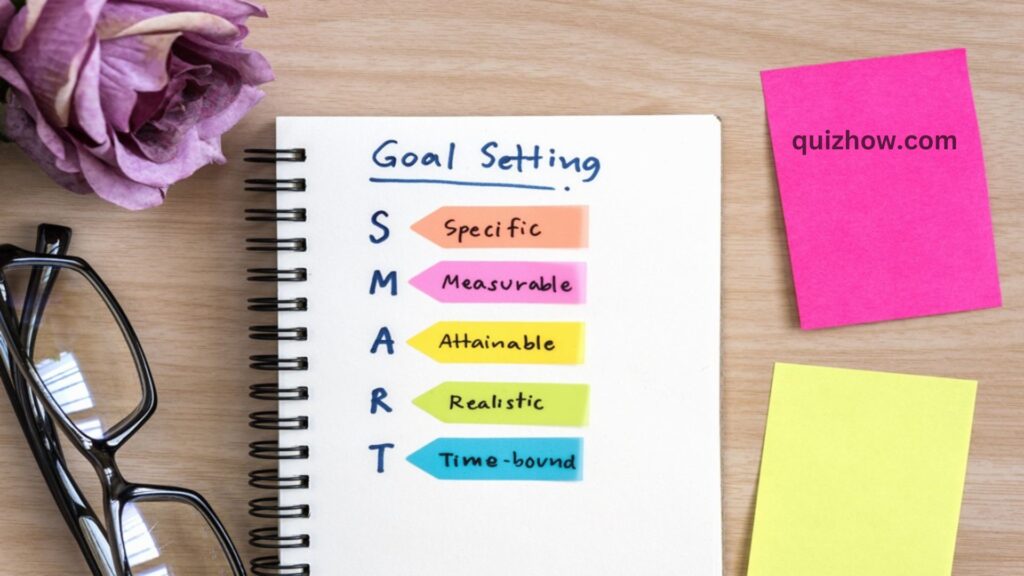If you’ve ever set a goal, you know how tough it can be to stay on track.
You might get distracted by Netflix or lose motivation when your plan to get abs by laughing for hours doesn’t work out.
But don’t worry! You can stay motivated and achieve your goals using a method called SMART goals.
So, what are SMART goals, and how can they help you succeed?
Relax! This post will explain what SMART goals are, give some examples, show you how to write them, and talk about the best goal-setting tool out there. Plus, we’ll cover the main benefits of using SMART goals.
Set your goals and get ready!
What Is a SMART Goal?
You’re not completely wrong if you think a SMART goal sounds like a clever idea someone came up with.
SMART goals help you create thoughtful and achievable goals. The acronym SMART stands for Specific, Measurable, Achievable, Relevant, and Time-bound. These standards help both groups and individuals set clear and realistic objectives.
If you’ve ever worked toward a vague goal without a way to track your progress, you should try SMART goals. They help you set realistic targets, define a clear timeline, and keep track of deadlines for both personal and professional goals.
How to Write a SMART Goal

Remember, SMART stands for Specific, Measurable, Achievable, Relevant, and Time-bound goals. To create clear and measurable goals, you need to consider each of these five components.
Let’s go through each step in the SMART goals framework:
1. Specific
To avoid setting a vague goal, you need a clear action plan. Just answer these common “w” questions:
- What: Describe exactly what you want to achieve.
- Who: List the people involved in your goal, especially important for team goals.
- When: Set a start date and an end date for your goal.
- Where: If relevant, choose a location for your goal.
- Why: Explain why you want to achieve this goal and how it fits into your future plans.
- Which: Identify any challenges or requirements that could affect your progress. For example, if your goal is to launch a new website but you have no web development experience, you’ll likely face obstacles.
Specific Goal Example: Increase organic traffic to your website by 10%.
2. Measurable
The next step is to figure out how you’ll measure progress toward your goal.
When you define these metrics, your goal becomes more concrete because you can clearly see how close you are to reaching it.
If you’ve set a long-term goal, keep yourself motivated by setting milestones along the way.
What are milestones?
Milestones are key achievements along your goal’s timeline. For example, if your goal is to launch a shopping website, creating the user interface can be a milestone.
Celebrating your milestones helps keep you motivated to achieve even more!
Measurable Goal Example: Check analytics monthly to increase organic traffic to your website by 10% by the end of Q1.
3. Attainable
Now, you need to figure out how achievable your goal is.
Setting a super challenging goal (like a stretch goal) can push you to perform better, but it might demotivate you if you can’t reach it.
Think about any new skills, attitude changes, tools, equipment, or courses you’ll need to achieve your goal.
If you’re missing a skill or certification, figure out how to get it.
Remember to consider your budget and time constraints!
Attainable Goal Example: To grow your online business, you’ll likely need to hire web developers. But you also need to decide if you can afford to pay them.
4. Relevant
Setting relevant goals ensures that your goals actually matter for your future.
If your SMART goals don’t align with your career plans or long-term personal aspirations, you might not feel very excited about achieving them.
For example, if you plan to run your own online retail business soon, you should focus on goals like taking courses in sales and marketing.
But if you set a goal to take stand-up comedy courses for the next three months, once you finish, you won’t feel any closer to your main goal.
Relevant Goal Example: Since your site’s organic traffic grew by 8% last quarter, it makes sense to aim for a 10% increase in organic traffic this quarter.
5. Time-bound
Goals need a deadline.
Without one, your goals might just keep dragging on, and so will your procrastination!
For example, when setting up a timeline for an online business, think about things like:
- Do I need to hire team members?
- Do I need to rent a space?
- What administrative documents do I need?
- How long will it take to find suppliers?

Time-Bound Goal Example: Increase organic traffic to your website by 10% by the end of Q1.
Once you answer these questions, you’ll have a better idea of how much time you need to reach your goal.
Also Read: DIY Floating Shelves for Effortless Storage
Benefits of Writing SMART Goals

Using SMART goals has the following two wonderful advantages:
1. SMART goals can improve self-development
Using a goal-setting framework like SMART goals can really help us on a psychological level.
Before setting a SMART goal, it’s important to understand our core values and make sure our goals align with them. This way, we’re more likely to benefit from them in the long run.
Also, when creating a SMART goal action plan, we need to be realistic about our abilities and set achievable expectations for ourselves.
For example, if you aim to become a senior marketing manager, you should ensure you have the necessary certifications. Otherwise, you might find yourself stuck.
Once we achieve our goals, we feel more confident and motivated to set and reach even more goals!
2. SMART goals are easy to work with
The SMART goal criteria are really easy to grasp, and you don’t need expensive tools or extensive training to use them.
That’s why this method is great for individuals and teams of any size.
For example, you can align your personal goals with your project management goals and KPIs to track progress without breaking the bank.
Let’s Get Smart About It!
The SMART framework helps you create a clear plan focused on achievable objectives.
While the SMART system is great for setting practical personal and career goals, using a tool like ClickUp can make things even easier. With features like Priorities, Goal Folders, and lots of Integrations, you won’t waste time manually tracking and documenting your goals.

Discover more from QuizHow
Subscribe to get the latest posts sent to your email.

